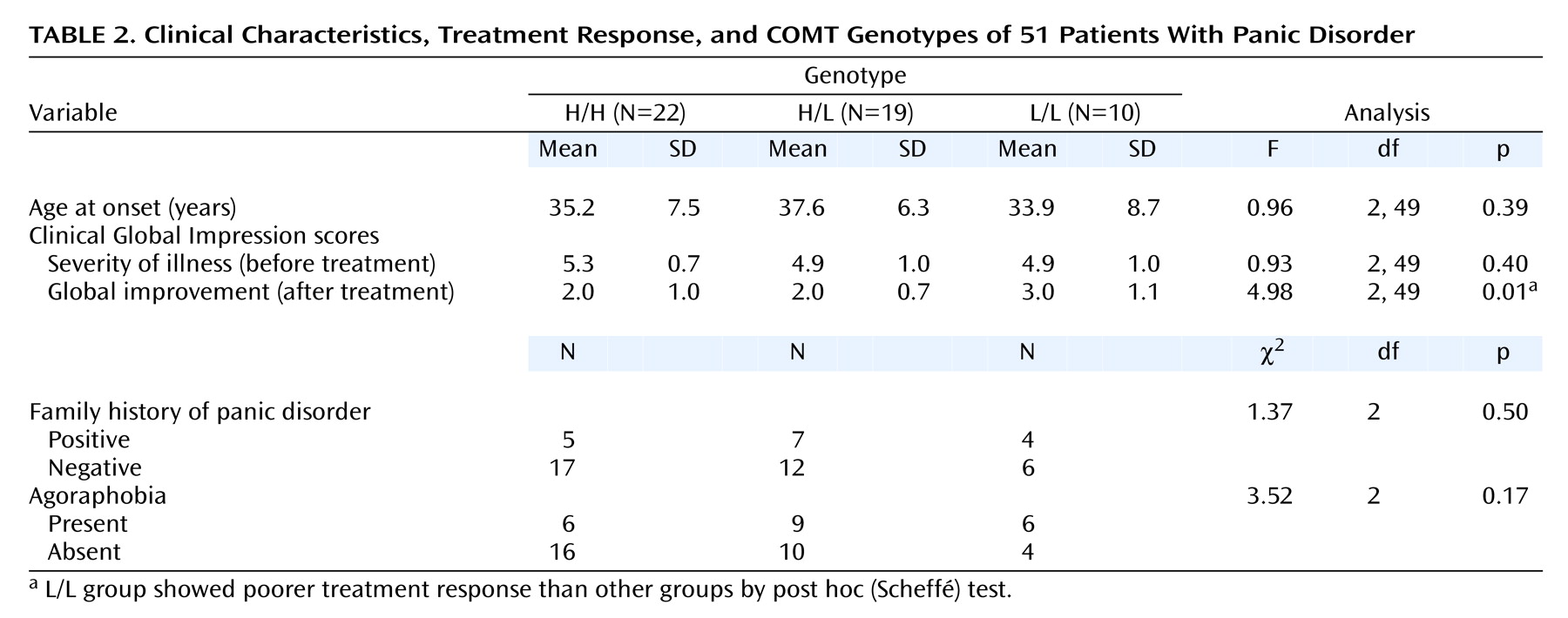Catechol
O-methyltransferase (COMT) is a ubiquitous enzyme that is involved in the inactivation of catecholamines
(1). Lachman et al.
(2) showed that a genetic locus modulating COMT activity exhibited allelic variation: the
COMTH(H) allele, associated with high activity, encodes for valine, and the
COMTL(L) allele, associated with low activity, encodes for methionine at position 108/158 in the cytosolic/membrane bound form of the protein. The difference in COMT activity resulting from this genetic polymorphism is substantial (threefold to fourfold). In view of the fact that somatic symptoms of anxiety and panic disorder are closely related to the activation of catecholamines and sympathetic pathways, the COMT gene may have a role in the etiology of panic disorder
(3).
The main goal of the current study was to determine the association between COMT genotypes and panic disorder. We also examined the association between COMT genotypes and clinical characteristics of panic disorder, including age at onset, presence of agoraphobia, and treatment response.
Method
Fifty-one unrelated patients who met DSM-IV criteria for panic disorder (26 men, 25 women, mean age=40 years, SD=8) participated in the study, and 45 healthy, sex-matched subjects (23 men, 22 women, mean age=37 years, SD=5) were included for comparison. All patients were recruited from Samsung Medical Center in Seoul, Korea; comparison subjects were recruited from workers at the same hospital through advertisement. After a complete description of the study was given to the subjects, written informed consent was obtained. This study was approved by the Institutional Review Board of Samsung Medical Center.
The patients had no comorbid major medical illnesses and no psychiatric illnesses other than panic disorder. They were treated with paroxetine, 20–40 mg/day, for more than 3 months. Comparison subjects were carefully assessed by two physicians to exclude any illnesses that may be related to abnormalities in catecholamine levels.
Genomic DNA was extracted from peripheral blood leukocytes by using a standard phenol-chloroform method. The
Val158Met polymorphism of the COMT gene (gene map locus: chromosome 22q11.2, G/A1947 polymorphism in HSCOMT 2 gene, gene bank accession number z26491, dbSNP: rs165388) was tested from a 217-bp polymerase chain reaction product amplified by using the oligonucleotide primers 5′-TCG TGG ACG CCG TGA TTC AGG-3′ and 5′-AGG TCT GAC AAC GGG TCA GGC-3′ (Bioneer, Seoul, Korea) as described elsewhere
(4). The polymerase chain reaction product was digested by the restriction enzyme
Nla III (New England Biolabs, Beverly, Mass.) for 6 hours at 37°C. After electrophoresis with 100 V for 35 minutes on 2% Metaphor agarose gels (FMC, Rockland, Maine) containing 0.5% ethidium bromide, the gels were photographed under ultraviolet light. Restriction fragments of 114, 83, and 20 bp revealed the
COMTH allele, and 96, 83, 20, and 18 bp revealed the
COMTL allele.
We used the Clinical Global Impression to assess clinical variables, including treatment response, in the patients with panic disorder. For statistical analysis we used the chi-square test for categorical measures and analysis of variance for comparing continuous measures. Odds ratios were estimated to evaluate an association between COMT genotypes and panic disorder. Analyses were run on SPSS software, version 10.0 (SPSS, Chicago).
Discussion
This study revealed that COMT activity might be related to susceptibility to panic disorder in that significantly higher proportions of the COMTL allele and L/L genotype were observed in patients with panic disorder than in healthy comparison subjects. The genotype distribution was significantly different, with evidence of a dose-dependent effect of the low activity allele.
Although the possibility that the COMT gene might have a role in panic disorder is intriguing, the results of previous reports on this issue have not been consistent
(5,
6), possibly because of ethnic differences or different sample sizes. The allelic frequencies of
COMTL were about 50% for Caucasians, 18% for Han Chinese, and 29% for Japanese, and the frequencies of L/L genotype were about 25% for Caucasians, 3% for Han Chinese, and 6% for Japanese
(4,
5,
7). The relatively low
COMTL frequency in Asian subjects may suggest a possible role of a COMT polymorphism in panic disorder. Lifetime prevalence rates of panic disorder in Taiwan, Japan, and Korea are as low as 0.4%, 1.0%, and 1.7%, respectively, but the rate in the U.S. population is 3.5%, according to estimates from the National Comorbidity Study
(8–
11). Thus the low frequency of the
COMTL genotype in Asian populations may explain this ethnic difference in the prevalence of panic disorder.
It should be noted that patients with panic disorder who have the L/L genotype showed poorer treatment response to pharmacotherapy than patients with other genotypes. Different COMT genotypes led to different levels of catecholaminergic activity in patients with panic disorder, which might have an effect on the response to pharmacotherapy. Thus our results suggest that a COMT genetic polymorphism may be an important factor in the development and treatment response of panic disorder.



